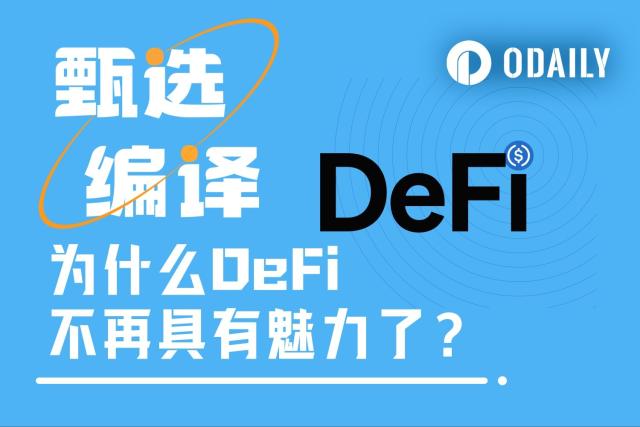Author: DeSpread Research
Compiled by: TechFlow

1 Introduction
Since the second half of 2023, the cryptocurrency market has experienced an upward trend, although there has been a correction after reaching an all-time high in March this year. As of June 30, the price of Bitcoin was around $60,800, down 16.7% from the peak of $73,000 in March. This shows that in the second quarter, the cryptocurrency market has seen a clear correction, in contrast to the performance in the first quarter. Several negative factors that led to this deeper correction include the start of the Mt. Gox repayment process and the possible sale of a large number of Bitcoins seized from illegal websites held by the German and US governments.
This article covers market trends, major issues, the development of centralized exchanges in South Korea, and news related to the implementation of the Korean Virtual Asset User Protection Act.
2. Market trends and main issues
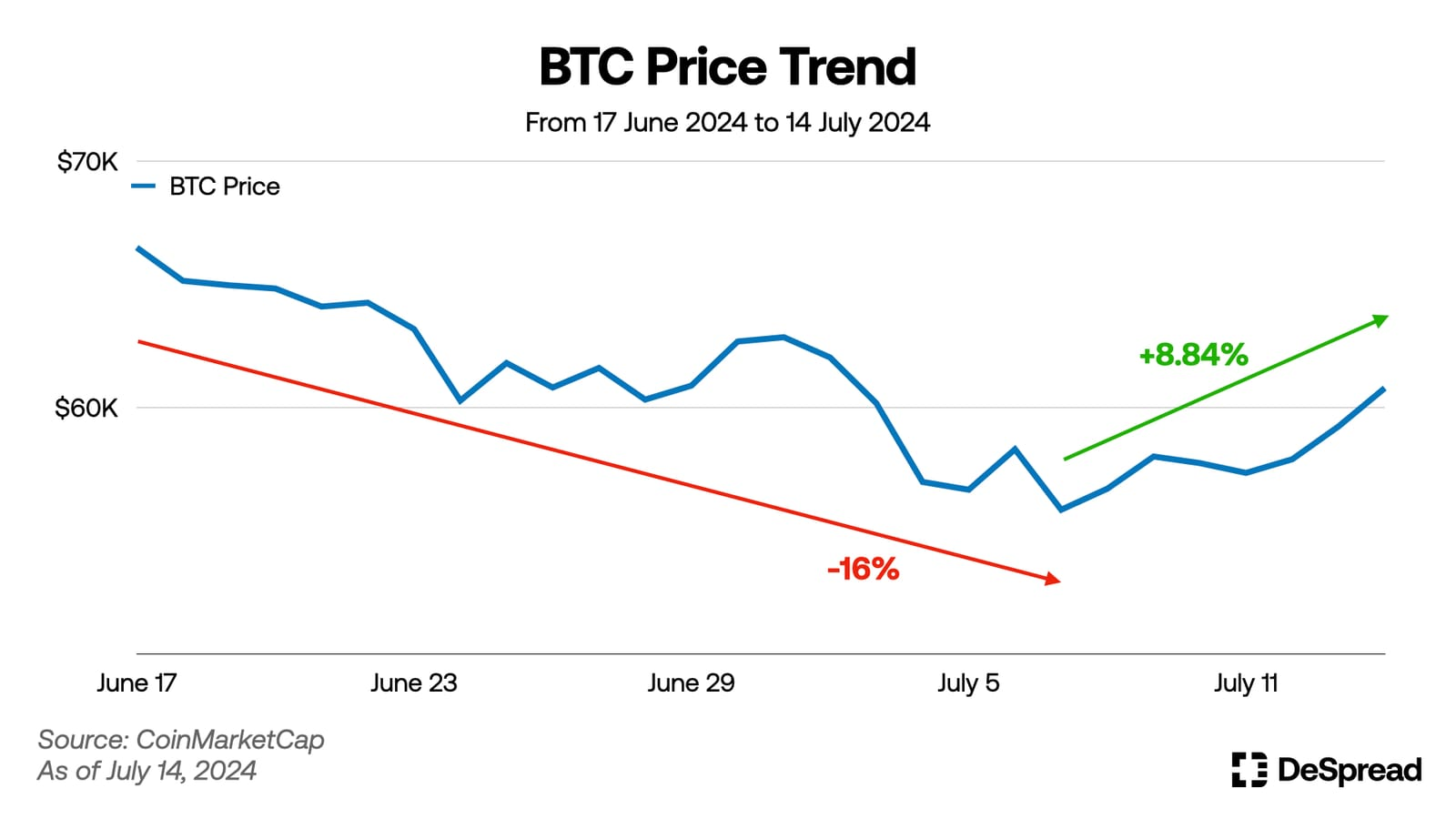
Several events in June and early July increased selling pressure on Bitcoin, causing its price to drop significantly. On June 19, Bitcoin held by the German government was transferred to exchanges and OTC wallets, followed by the transfer of Bitcoin held by the U.S. government on June 26. In addition, the repayment process for Mt. Gox creditors began on July 5. Together, these events caused the price of Bitcoin to drop by as much as 18% from $66,500 on June 17 to below $55,000 on July 5.
According to data from cryptocurrency derivatives data provider Coinglass, the market sentiment index (Fear & Greed Index) reflects these changes. During this period, the index fell from near the "extreme greed" level (74) to above the "extreme fear" level (25), showing a significant shift in investor sentiment.
2.1 Government Actions and Mt. Gox
2.1.1 German Government
On January 30, 2024, police in the eastern German state of Saxony announced the seizure of approximately 50,000 Bitcoins from the operators of the illegal movie piracy website 'movie2k.to', which was active between 2008 and 2013. The two operators of the site began using the site's revenue to purchase Bitcoins from mid-2012, and reportedly used more than 22,000 Bitcoins to purchase various assets, including real estate.
One of the operators was detained in November 2019 and released after transferring approximately $29.6 million worth of Bitcoin and Bitcoin Cash to the Dresden Prosecutor's Office in 2020. According to data from the on-chain data platform Arkham, on January 19, 2024, the operator transferred an additional 50,000 Bitcoins to the German Federal Criminal Police Office (Bundeskriminalamt, BKA).
Starting from June 19, the BKA began to transfer the seized Bitcoin to several cryptocurrency exchanges including Coinbase, Kraken and Bitstamp. This move raised concerns that these Bitcoins might be sold on the market, leading to the recent market decline.
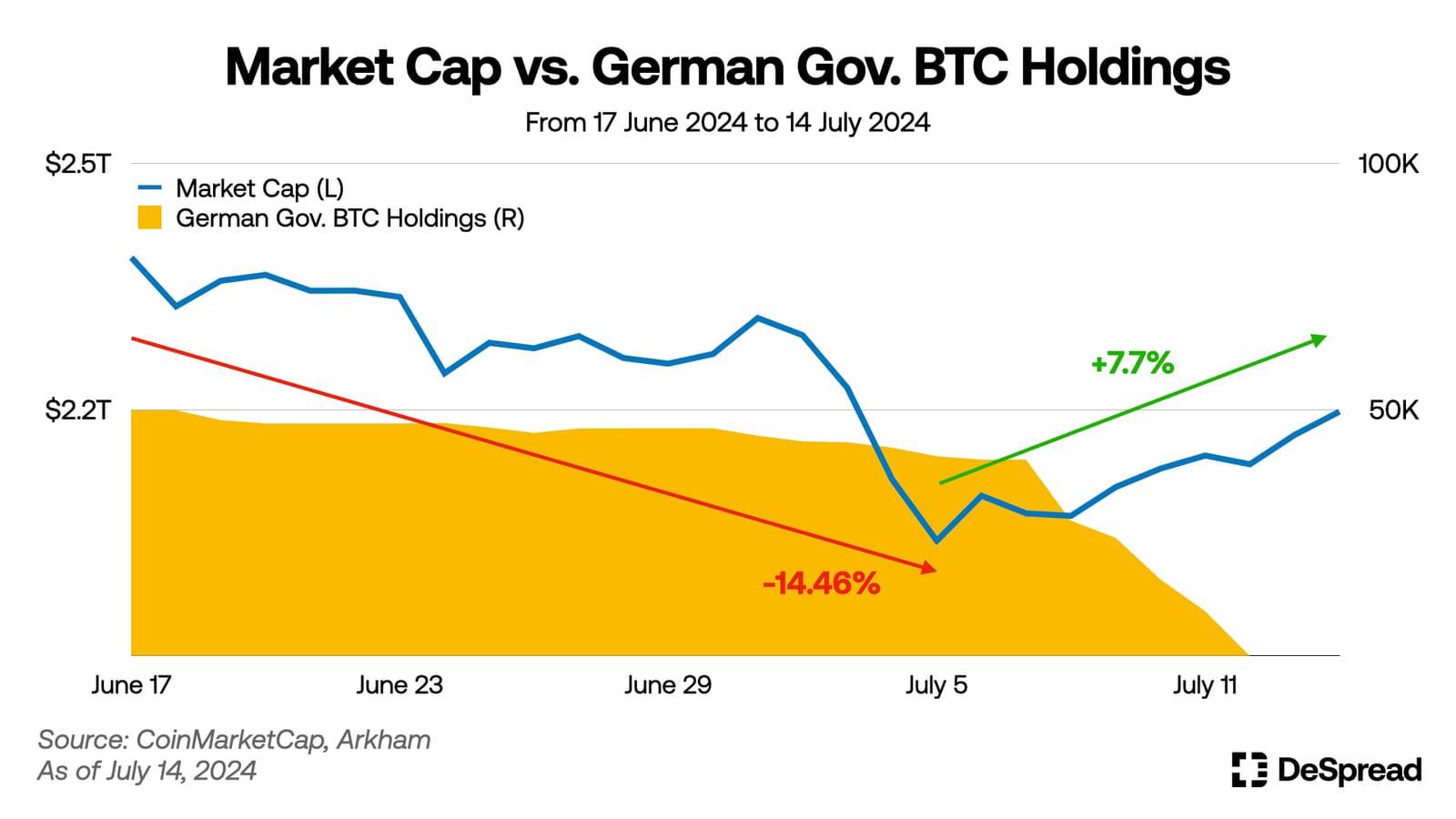
Overall, the total cryptocurrency market capitalization also fell by 14.5% from the third week of June to July 5, in line with Bitcoin's trend. It is worth noting that 40,000 of the 50,000 Bitcoins seized by the German government were moved to exchanges or other wallets after July 5, possibly for sale. This suggests that the market decline of about three weeks may have been driven by panic in anticipation of this negative development.
German government Bitcoin holdings weekly trend
The third week of June (06.17 - 06.23)
June 17: 49.86K BTC
June 23: 47.18K BTC
Bitcoin net outflow: -2,680 BTC
Fourth week of June (06.24 - 06.30)
June 24: 47.18K BTC
June 30: 46.19K BTC
Bitcoin net outflow: -987.24 BTC
First week of July (07.01 - 07.07)
July 1: 46.19K BTC
July 7: 40.53K BTC
Bitcoin net outflow: -5,670 BTC
Second week of July (08 July - 14 July)
July 8: 39.83K BTC
July 14: 0 BTC
Bitcoin net outflow: -39,830 BTC
2.1.2 US Government
According to Arkham data, the U.S. government holds about 213,000 BTC, most of which were seized from hacks of the Dark Web market Silk Road and cryptocurrency exchange Bitfinex.
Silk Road operated from 2011 to 2013, using Bitcoin to trade in illegal goods, including drugs. The FBI shut down the site in October 2013, and in November 2020, the U.S. Department of Justice seized more than 69,000 BTC from the site's revenue. In 2021 and 2022, an additional 2,875 BTC and 51,680 BTC were seized from Ryan Farace and Silk Road hacker James Zhong, respectively, who illegally sold drugs on Silk Road.
Additionally, in February 2022, more than 94,000 BTC were seized from Ilya Lichtenstein, who was involved in the hack of the Bitfinex exchange.
Over the past month, as the German government has continued to sell Bitcoin, market attention has turned to the Bitcoin holdings of various governments, including the US government. On June 26, the US government transferred 3,940 BTC to Coinbase, which drew attention to its holdings, which are more than four times that of the German government.
2.1.3 Mt. Gox
Mt. Gox was once the world's largest exchange, founded in 2010, but was hacked several times between 2011 and 2014, resulting in the theft of up to 950,000 BTC. The exchange declared bankruptcy in February 2014. After years of legal battles, Mt. Gox announced a recovery plan in 2021 to return recovered Bitcoin to users. On July 5, 2024, it began to repay 140,000 BTC to creditors.
To date, two transactions related to the Mt. Gox repayment process have been confirmed. On July 5, 1,545 BTC were sent to the Japanese exchange Bitbank, and on July 16, 48,641 BTC were transferred to an unconfirmed address that was later confirmed to be associated with the U.S. cryptocurrency exchange Kraken via an email sent to Mt. Gox creditors.
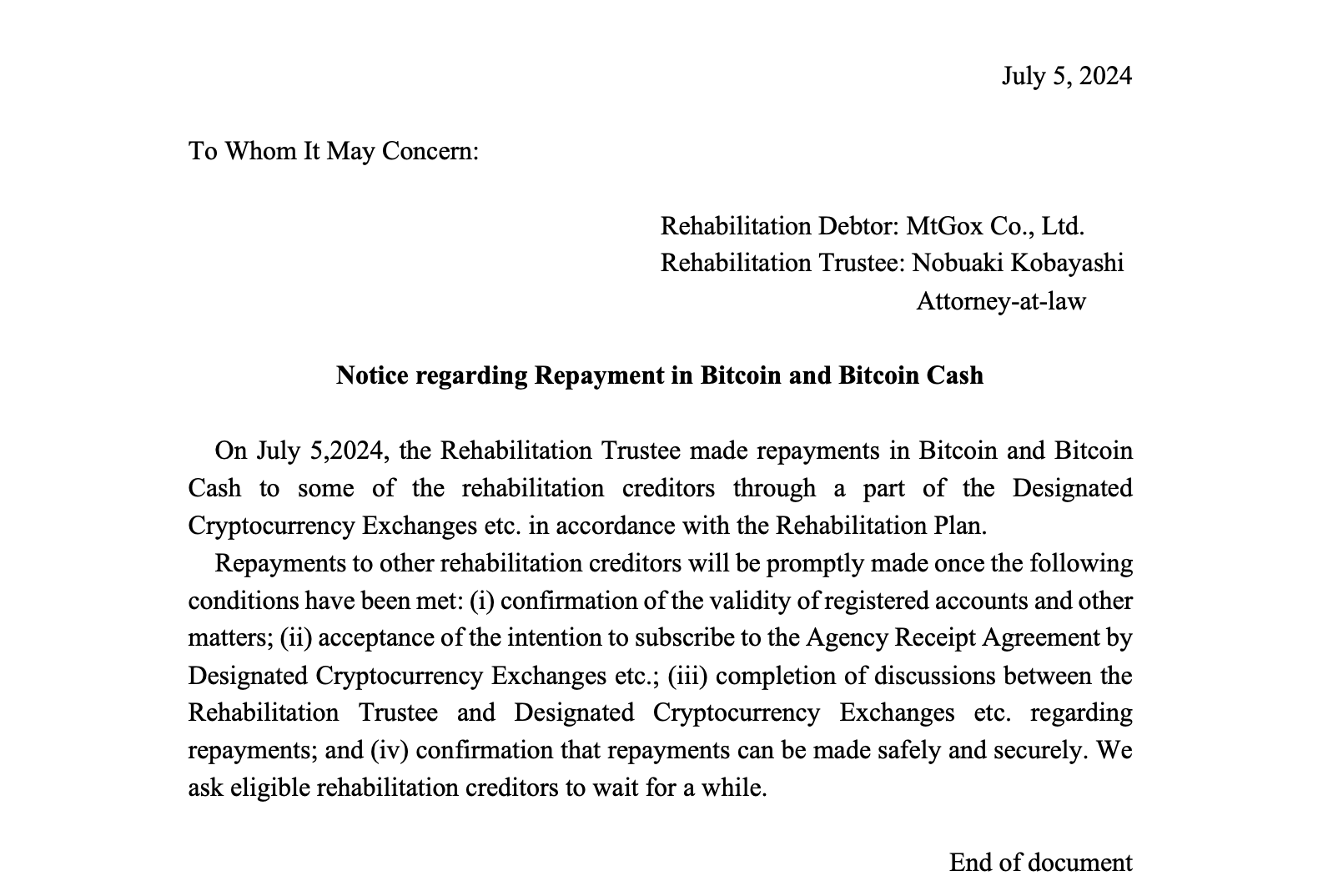
The main content is "Notice on Repayment of Bitcoin and Bitcoin Cash":
On July 5, 2024, the reorganization trustee repaid some reorganization creditors in Bitcoin and Bitcoin Cash through some designated cryptocurrency exchanges in accordance with the reorganization plan.
Repayment of other restructuring creditors will be made immediately upon satisfaction of the following conditions:
i) Confirmation of the validity of the registered account and other matters; ii) The designated cryptocurrency exchange, etc. accepts the intention to sign the agency collection agreement; iii) The completion of the discussion between the reorganization trustee and the designated cryptocurrency exchange, etc. on repayment; iv) Confirmation that the repayment can be made safely and reliably. We ask eligible reorganization creditors to wait patiently for a while.
Mt. Gox notice on repayment, source: Mt. Gox
With the Bitcoin moves from the German government on June 19, the U.S. government on June 26, and Mt. Gox on July 5 and July 16, market participants expressed concerns about the potential for selling pressure after the completion of the creditor distribution. On July 5, when the Bitcoin move to Bitbank was detected, the Bitcoin price fell by about 3%. Similarly, the transfer of about 48,000 BTC on July 16 temporarily stalled the market.
2.2 Trump assassination attempt and subsequent trends
As of July 16, Bitcoin price has risen by about 16.3% from the lows to over $64.9K, showing signs of market recovery. Multiple factors contributed to this recovery. First, the entire sale of about 50,000 BTC by the German government relieved the selling pressure. In addition, Trump’s re-election odds rose to 71% after the assassination attempt, which is good for the cryptocurrency. The potential approval of an Ethereum spot ETF also added to the market optimism. Finally, the strong support near the 200-day moving average played an important role in the market recovery. Together, these factors suggest that the market is regaining momentum, reflecting the recovery of investor confidence and positive sentiment.
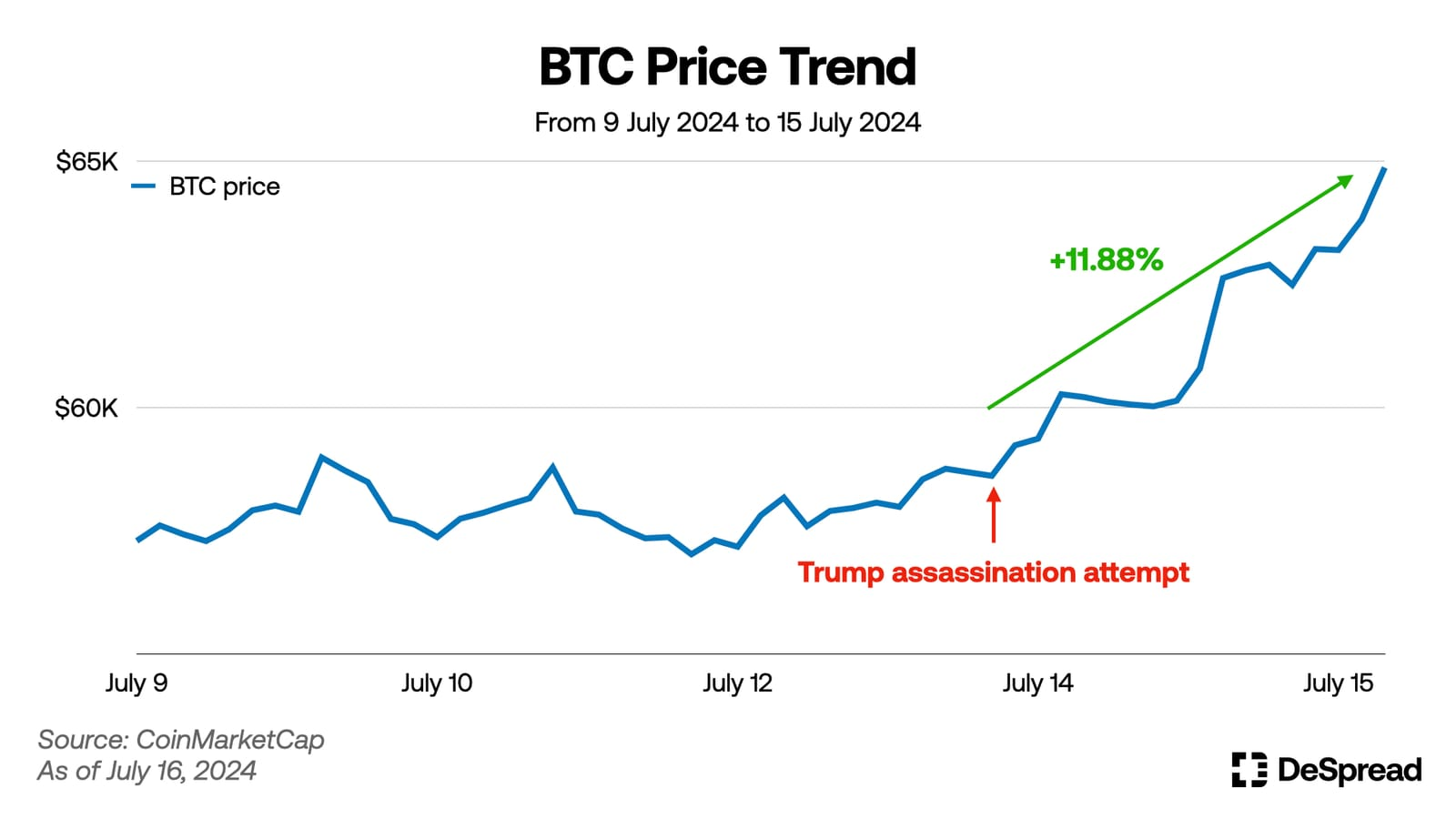
On July 13, Trump suffered an assassination attempt at a campaign rally in Pennsylvania, after which his election probability rose to 71% on Polymarket. Meanwhile, as of July 15, the price of Bitcoin rose by about 12%, approaching $65K. Trump's Republican Party has always been favorable to cryptocurrencies. They voted to repeal SAB121 and pass FIT21, and have been opposing lawsuits against cryptocurrency businesses related to SEC Chairman Gary Gensler.
SAB121: A bill that would require financial institutions to record cryptocurrencies held in custody as liabilities on their balance sheets.
FIT21: A bill designed to promote innovation in the U.S. digital asset ecosystem while strengthening consumer protection. It gives the CFTC new jurisdiction over digital commodities and clarifies the SEC’s jurisdiction over digital assets.
In addition, Trump, the Republican presidential candidate, has been a major supporter of Bitcoin. He launched the official Trump NFT in December 2022 and made multiple statements in support of Bitcoin, establishing himself as an important figure in the cryptocurrency industry. On July 16, Trump formally nominated JD Vance, a well-known cryptocurrency supporter, as his vice presidential candidate, further raising expectations that the Trump administration will implement regulations and market structures that are favorable to cryptocurrencies.
Although the German government’s Bitcoin sales have been completed, Trump’s assassination attempt and the potential approval of an Ethereum spot ETF have injected optimism into the market, challenges remain to sustain a sustained bull trend. Selling pressure from the Mt. Gox repayment and the U.S. government’s Bitcoin holdings must be resolved. In addition, lower Fed rates and crypto-friendly regulations established after Trump’s election could support a sustained uptrend.
2.3 ETF and Institutional Fund Inflows
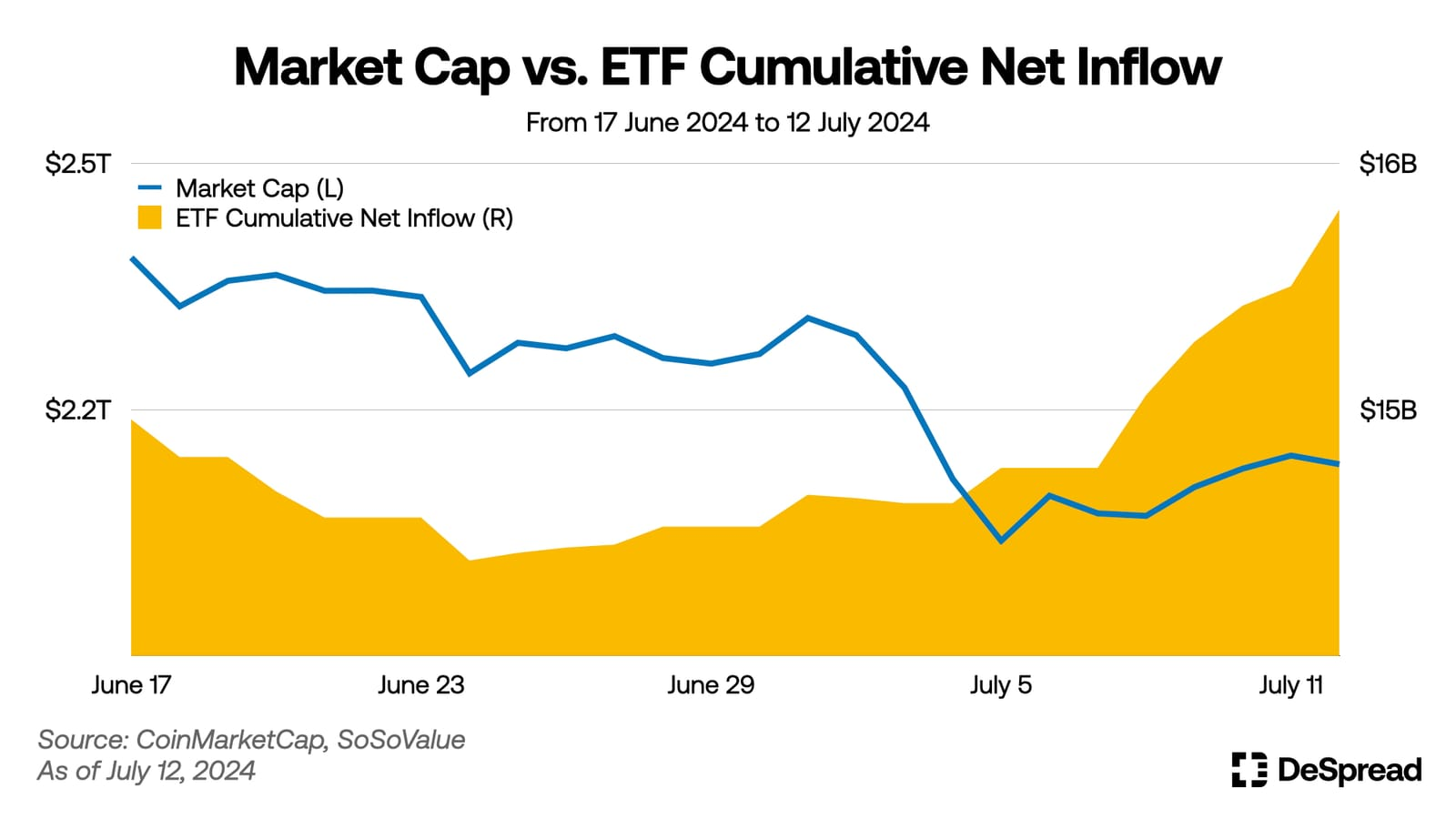
The chart shows the trend of the total cryptocurrency market capitalization and the cumulative net inflows of Bitcoin spot ETFs from June 17 to July 12, 2024. As of July 12, the net assets of Bitcoin spot ETFs are as follows:
Total net assets of Bitcoin spot ETFs: $51.34 billion (4.52% of the total Bitcoin market cap)
Cumulative net inflow: $15.81 billion
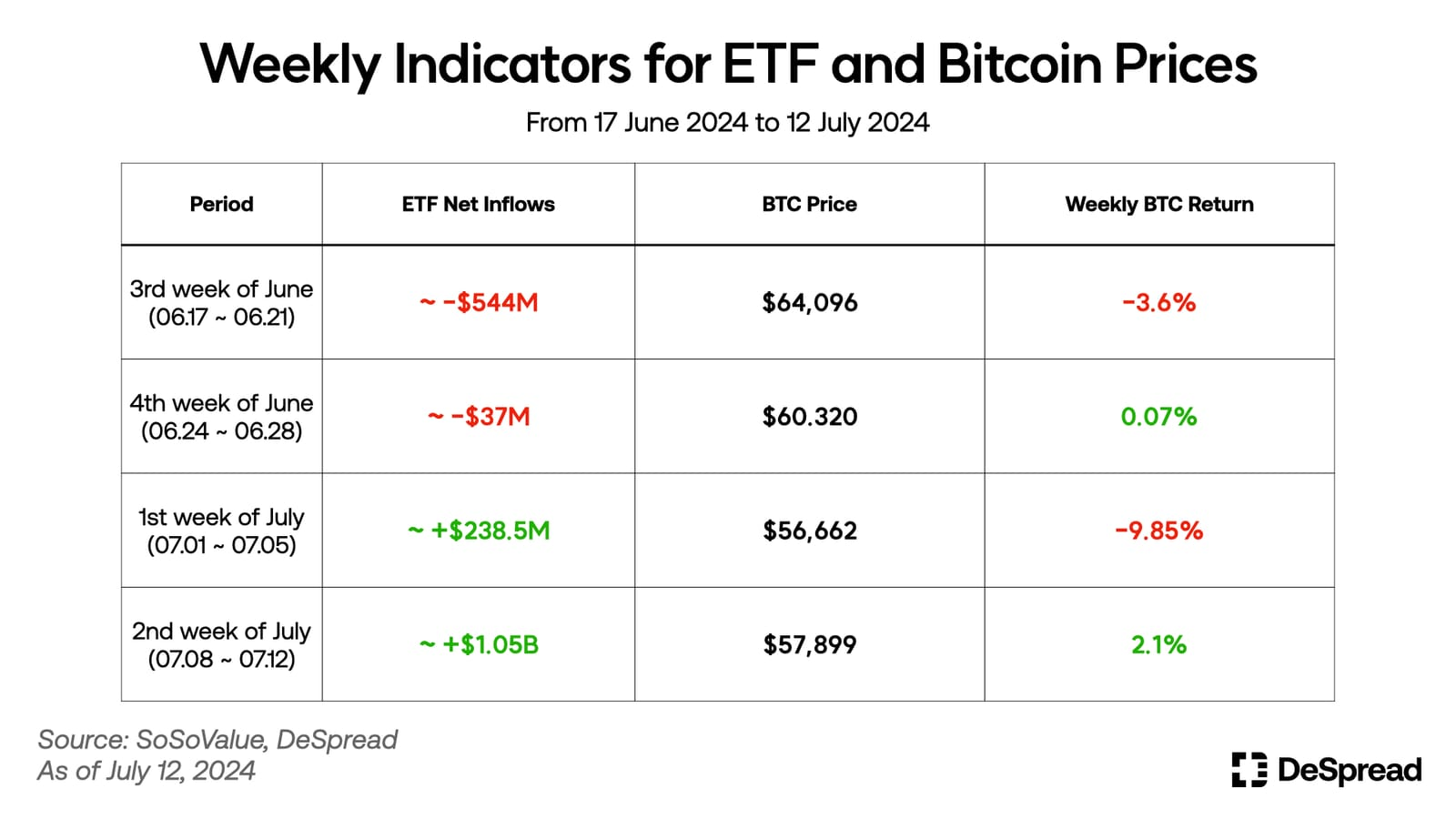
In previous reports , it was noted that ETF net inflows and Bitcoin market capitalization showed similar trends during June. However, in the first week of July (07.01 - 07.05), Bitcoin prices fell by about 10%, while Bitcoin spot ETF net inflows increased. This shows that the correlation between ETF inflows and Bitcoin market capitalization weakened during this period. In the second week of July (07.08 - 07.12), Bitcoin spot ETFs inflows additional $1.05B, bringing the cumulative net inflows to approximately $15.81B.
2.4 CME Open Interest Metrics and Institutional Participation
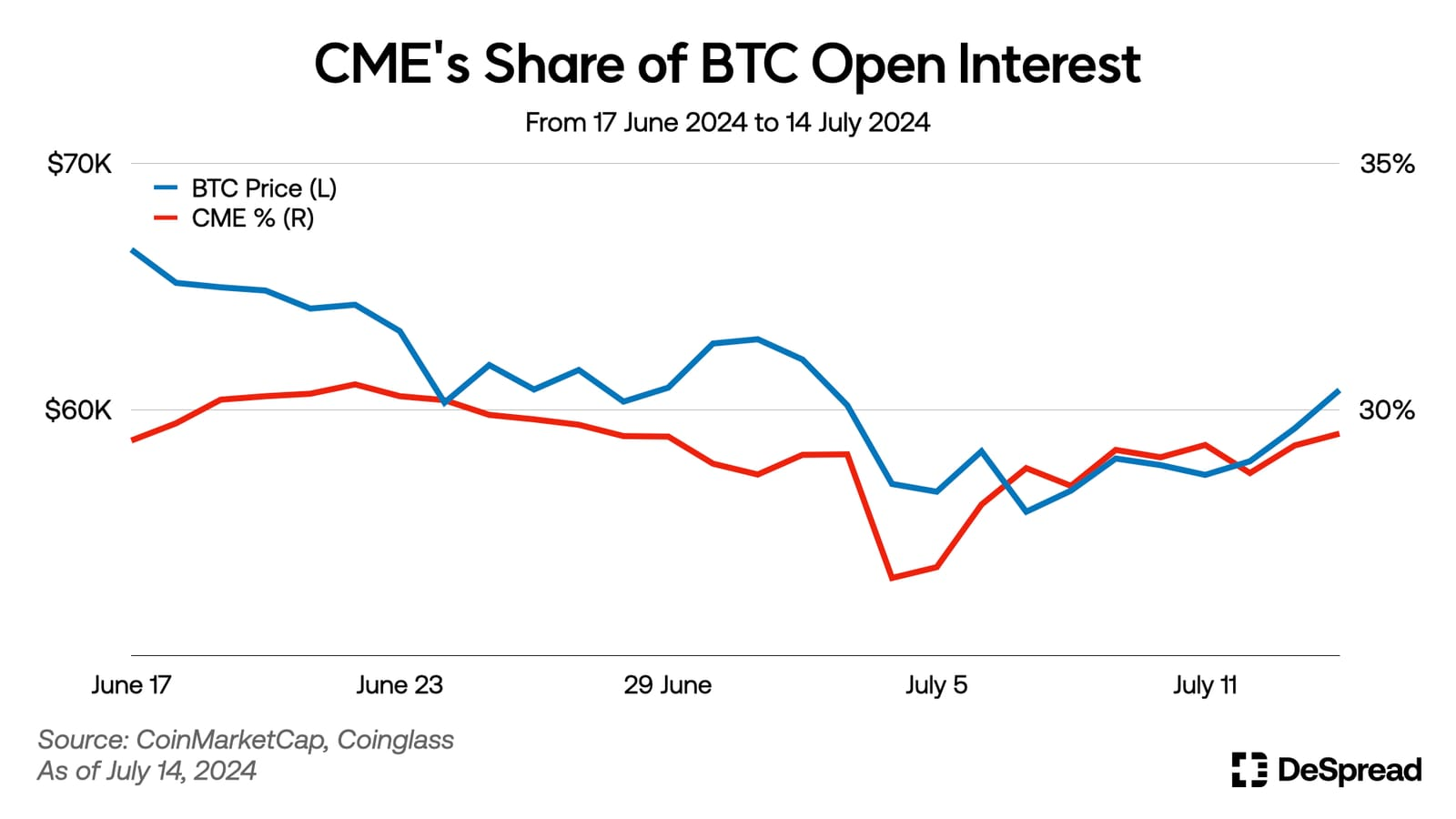
The Chicago Mercantile Exchange (CME) is one of the world's largest derivatives exchanges and has offered Bitcoin futures trading since December 2017. As a derivatives exchange regulated by the Commodity Futures Trading Commission (CFTC), CME only allows individuals and institutions that meet the CFTC and CME's financial resources and credit standards to trade. Therefore, most of CME's members are financial institutions that manage large-scale assets, such as asset management companies and hedge funds.
Due to these strict requirements, CME's open interest (OI) is considered a key indicator of institutional activity. Since the approval of the Bitcoin spot ETF, CME's share of Bitcoin open interest peaked at 33% in late March. Although it briefly fell to 27% in early May, it has since rebounded.
As shown in the chart, over the past month (June 17 to July 14), CME’s share of Bitcoin open interest has remained stable between 29% and 30%. A short-term low of 26.6% was reached on July 5, but it has since risen steadily and is currently around 30%.
3. South Korea’s centralized exchanges
3.1 Listing Trends and Coinone’s Strategy
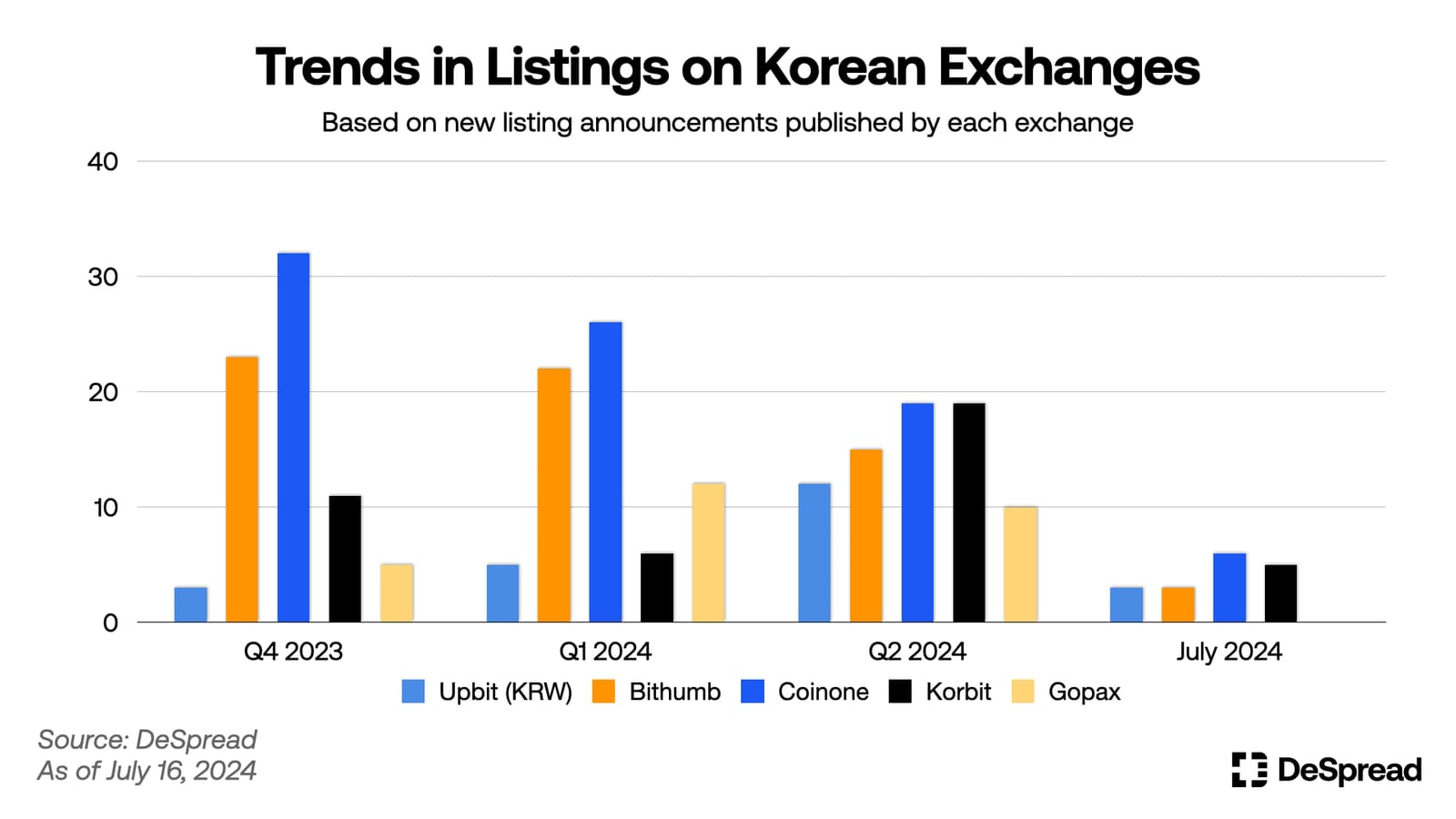
The chart shows the listing trends of the top five Korean exchanges (Upbit, Bithumb, Coinone, Korbit and Gopax) from Q4 2023 to July 2024. For Upbit, only listings from the KRW market are considered. The total number of listings on the top five exchanges is relatively stable, with 74 in Q4 2023, 71 in Q1 2024, and 75 in Q2.
Among them, Coinone has been leading in the number of listings and has adopted the most aggressive listing strategy. Coinone has not only performed well in the number of listings, but has also paid significant attention to the Memecoin field. In June, Coinone listed Cat in a Dog's World (MEW) and Book of Meme (BOME), and in July it listed Brett (BRETT) and Wen (WEN). This aggressive Memecoins listing strategy highlights Coinone's rapid adaptation to market trends, which began with the listing of MEME and BONK in the fourth quarter of 2023.
[Memecoins listings on various exchanges during the analysis period]
Upbit: No case
Bithumb: BONK (May 2024), MEW (June 2024), BRETT (July 2024) - 3 cases in total
Coinone: MEME (November 2023), BONK (December 2023), MYRO (February 2024), MEW (June 2024), BOME (June 2024), BRETT (July 2024), WEN (July 2024) - 7 cases in total
Korbit: BONK (April 2024) - 1 case in total
Gopax: No case
Bithumb consistently ranks second in terms of the number of listings, while South Korea’s largest exchange, Upbit, took a more cautious approach to new listings until Q1 2024. However, since Q2 2024, Upbit has become more active in listing new cryptocurrencies, with the number of its listings increasing to 12 from 5 in the previous quarter. This change indicates an increasingly fierce competition for trading volume share among major South Korean exchanges.
3.2 Competition for the Third Place
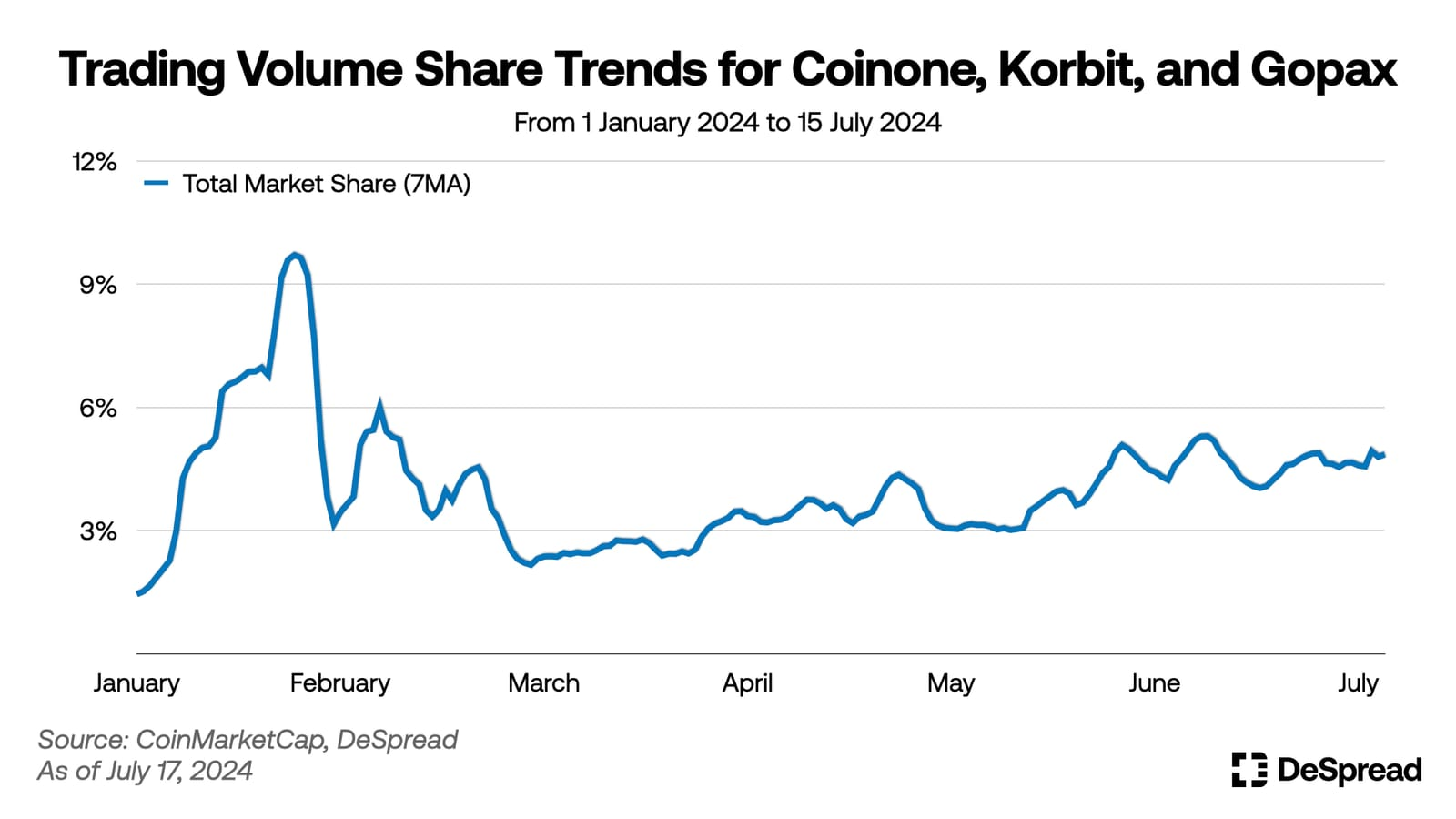
In the Korean cryptocurrency market, the trading volume share of the top five exchanges is mainly occupied by Upbit and Bithumb, which together account for about 95% of the market. Coinone, Korbit and Gopax share the remaining market share. In January 2024, the combined trading volume share of Coinone, Korbit and Gopax (based on a 7-day moving average) exceeded 9%. This surge was mainly attributed to Korbit's activities focusing on WEMIX trading volume that month.
The combined market share of these three exchanges fell below 3% in March but has gradually risen since then, reaching around 4-5% as of this writing.
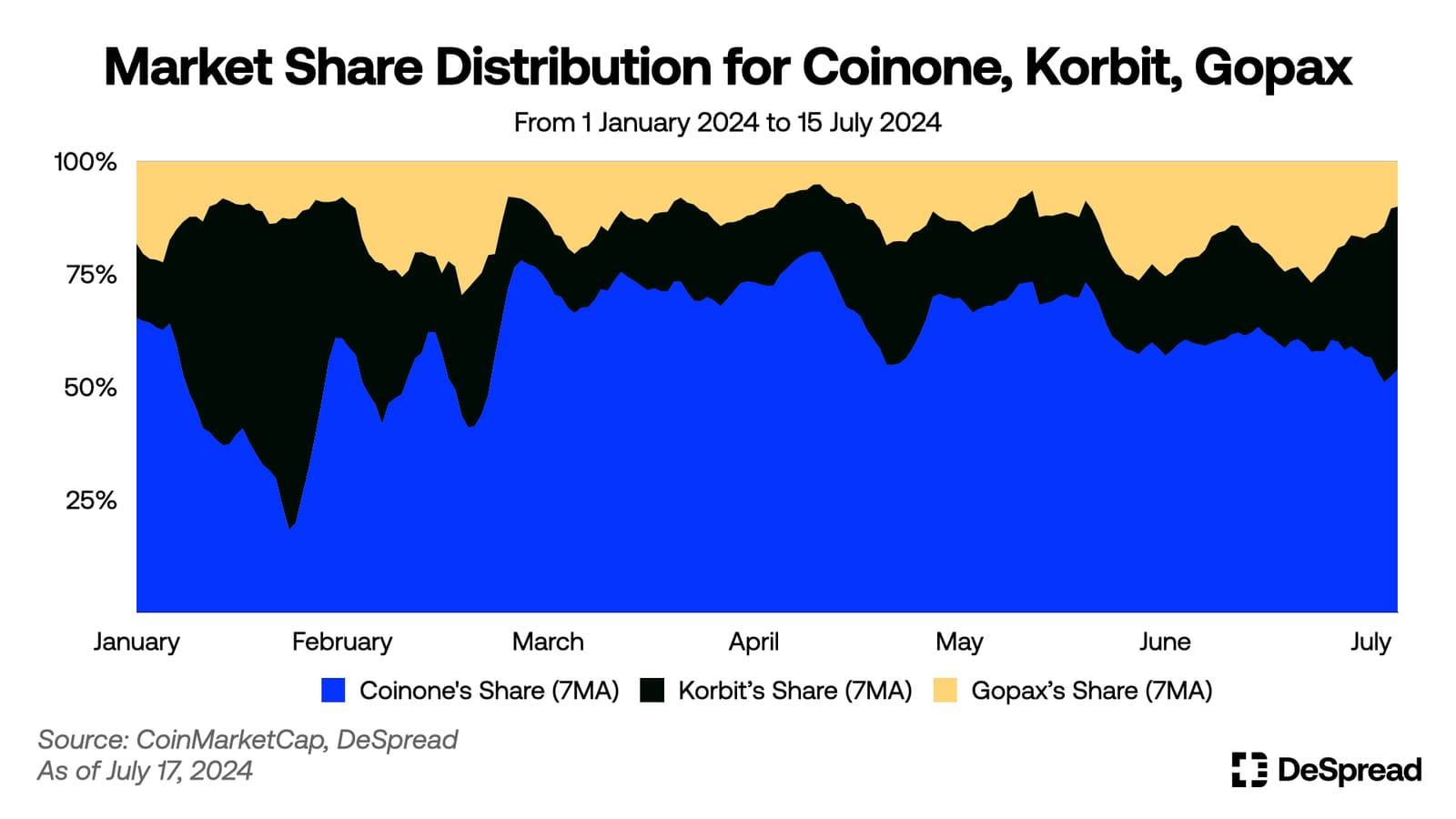
Analyzing the volume share distribution between Coinone, Korbit and Gopax, Coinone has remained stable in third place with a market share of over 50% for most of the time. However, in January, Korbit’s market share briefly surged to 88.8% due to WEMIX deposit and volume activity.
Coinone, Korbit and Gopax are all actively listing new cryptocurrencies and hosting trading support events to attract users and increase trading volume. Korbit and Gopax continue to challenge Coinone's seemingly stable third position, making the competition dynamic and worth watching.
3.3 Upbit’s advantages in a bull market and competitors’ advantages in a bear market
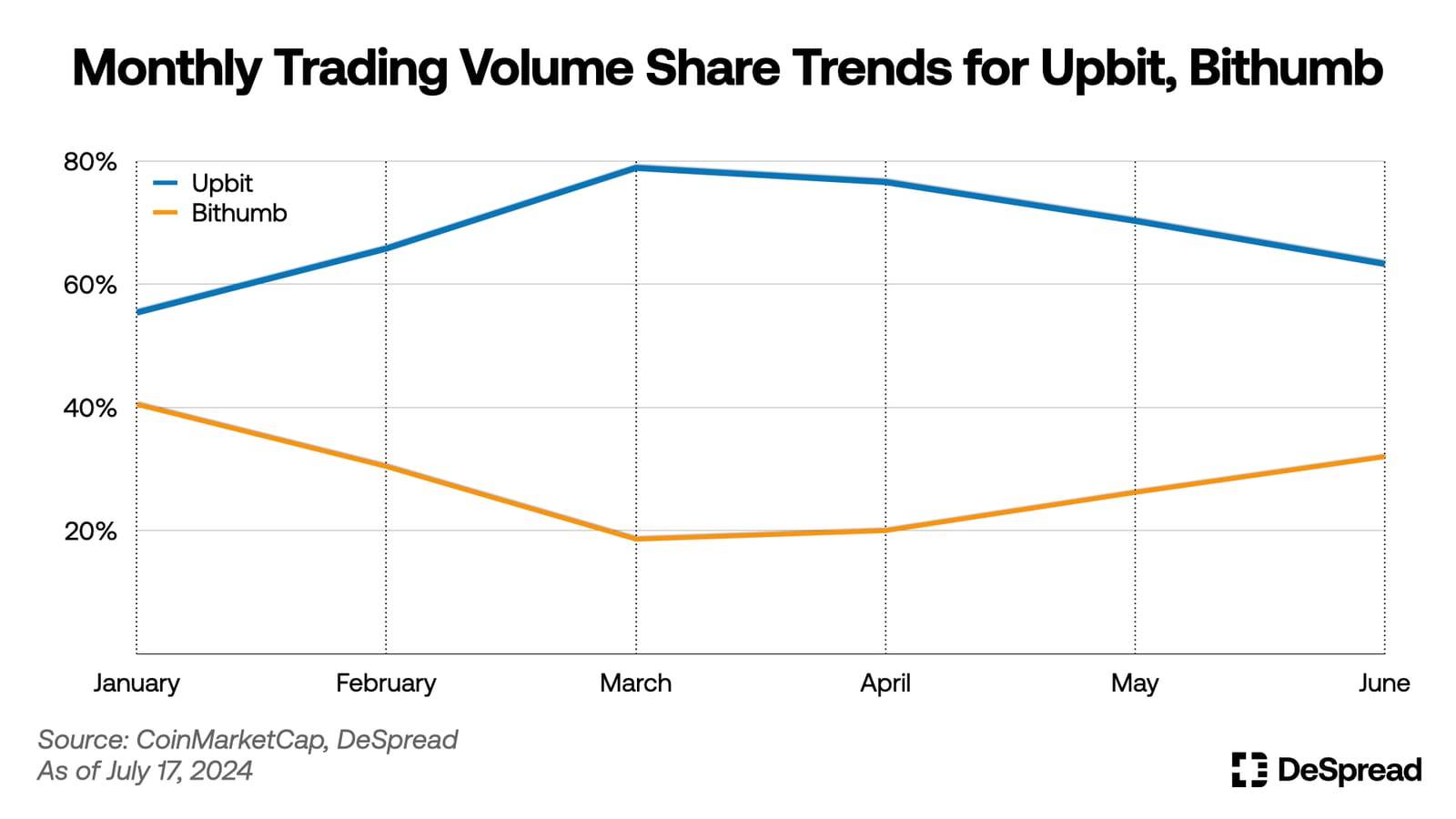
As mentioned in “ DI-04: Market Commentary ”, Upbit has demonstrated significant dominance, accounting for up to 80% of the market share. During the bull run in the first quarter of 2024, Upbit’s share soared from 55.4% in January to 78.9% in March. Meanwhile, Bithumb’s market share dropped from 40.5% to just 18.6%, highlighting Upbit’s unrivaled ability in the bull run.
However, as the cryptocurrency market entered a period of adjustment in the second quarter of 2024, the gap between Upbit and Bithumb’s market share began to narrow. Upbit’s market share fell by about 16% from its peak of 78.9% in March to 63.3% in June, while Bithumb’s market share rose from 18.6% to 32% during the same period.
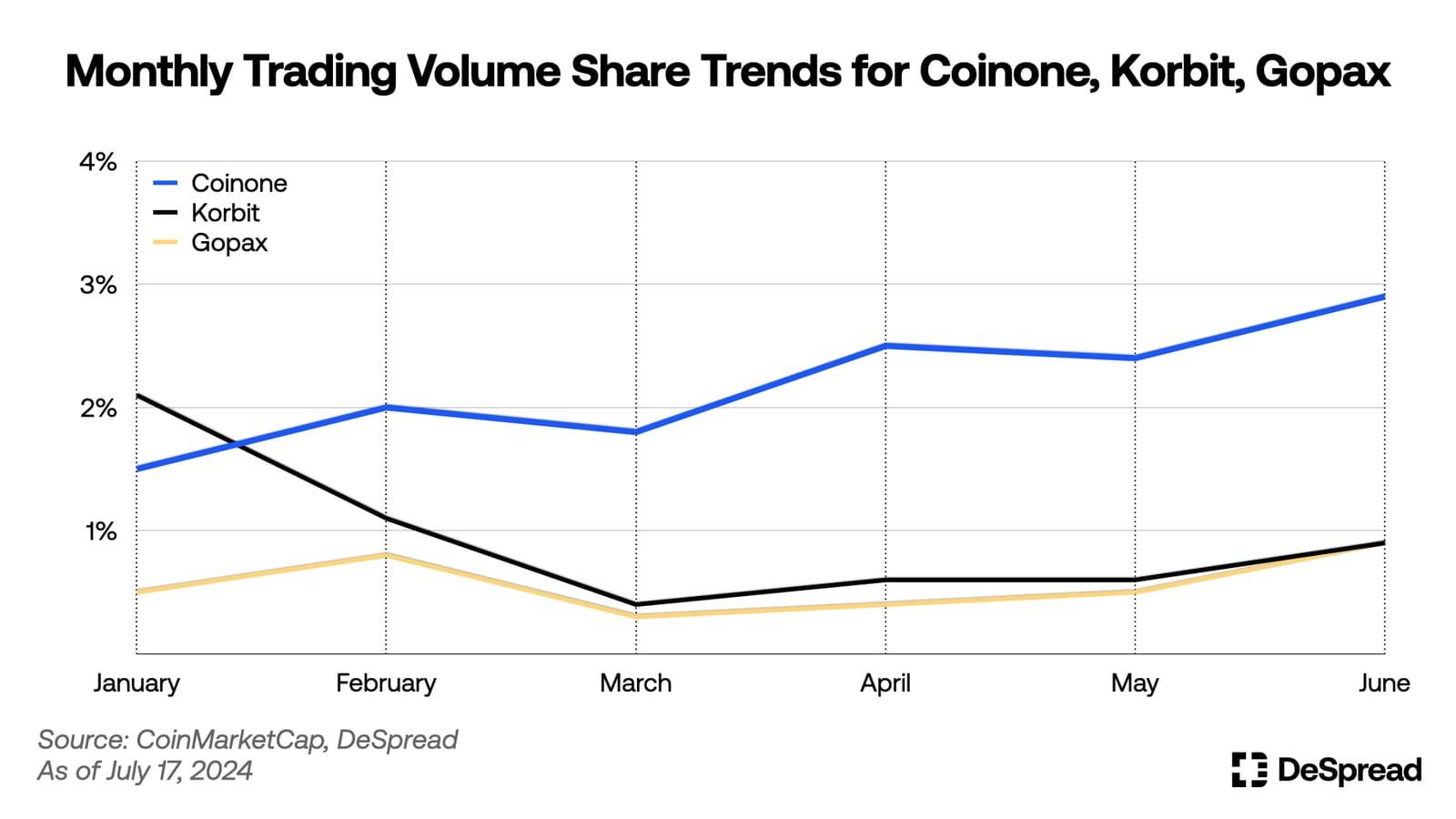
Similar to Bithumb, the other three exchanges – Coinone, Korbit and Gopax – also saw an increase in their trading volume market share during the market correction phase. Coinone, in particular, saw its monthly trading volume market share increase from 1.8% in March to 2.9% in June, a growth rate of approximately 61%.
4. Virtual Asset User Protection Law and General Guidelines
On July 19, the first phase of the Virtual Asset User Protection Act (hereinafter referred to as the "Virtual Asset Act") will officially come into effect. The law is mainly committed to defining virtual assets, protecting investor funds, regulating unfair trading practices, and enhancing the supervisory power of financial regulators. For detailed background and specific content of the Virtual Asset Act, please refer to the previous article "Overview of Cryptocurrency Regulation in South Korea".
Market participants are particularly concerned about the general guidelines for the listing and delisting of more than 600 virtual assets currently supported under the law. These guidelines, jointly developed by the Financial Supervisory Service (FSS) and the Digital Asset Exchange Alliance (DAXA), apply to domestic companies and international projects and have a significant impact on the future trends of the Korean virtual asset market.
According to a press release issued by DAXA on July 2, the evaluation of new virtual asset listings will combine formal and qualitative criteria and be maintained and reviewed quarterly. The formal criteria include some hard requirements, and if they are not met, they will not be listed. The qualitative criteria involve a comprehensive assessment of various factors related to virtual assets. The main points of the formal criteria announced by DAXA are as follows:
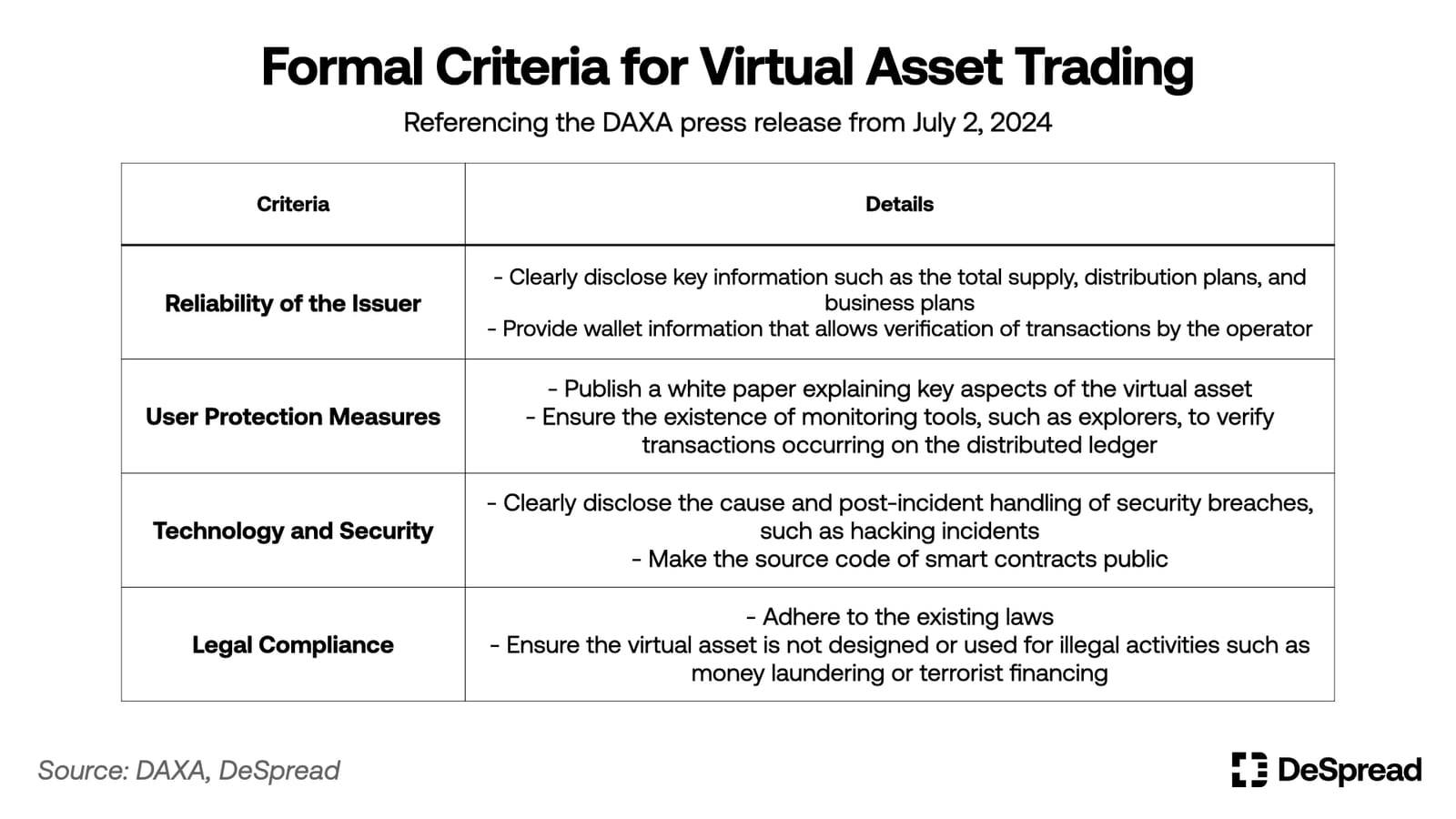
While the main goal of the first phase of the Virtual Asset Law is to establish basic order to protect investors by regulating unfair transactions, the upcoming second phase of legislation needs to address the further establishment of market order, including the refinement of issuance, disclosure and distribution regulations, as well as various areas of the blockchain industry.
In refining the issuance, disclosure and distribution regulations, the focus will shift from the unified regulations applied to virtual assets and virtual asset businesses in the first phase. The second phase aims to apply segmented regulations based on the functions and underlying assets of virtual assets and the types of services provided by businesses.
Furthermore, in order to promote the overall development of the domestic virtual asset industry beyond user protection, it is necessary to improve regulations, especially in areas that lack comprehensive regulation compared to other countries. These areas include the issuance and distribution of stablecoins, the blockchain gaming industry, and the regulation of virtual asset spot ETFs. By doing so, the Korean market can improve its competitiveness on the global stage.





